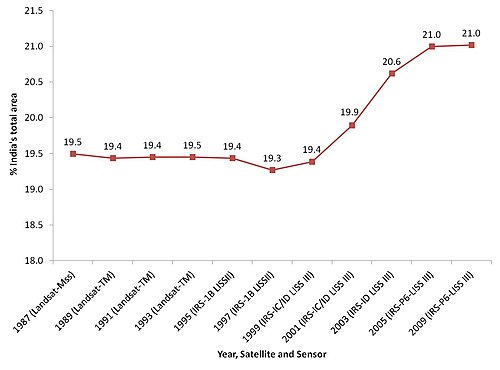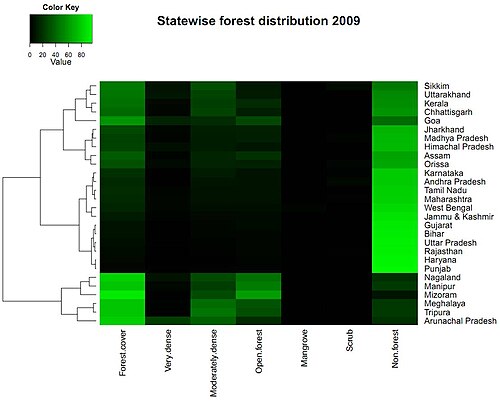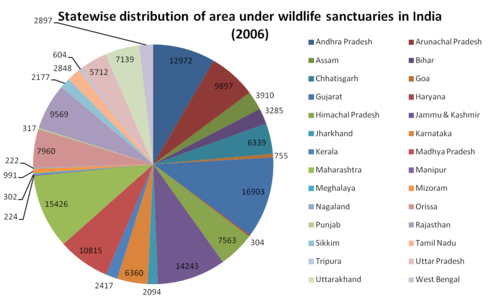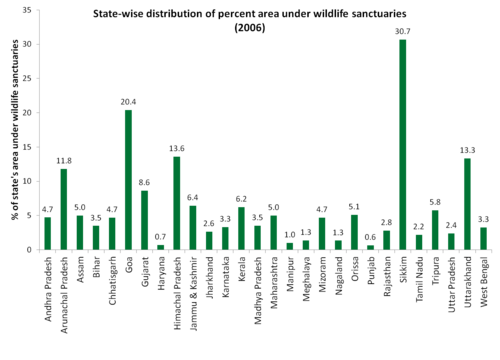Forest cover in India
Forest cover in India
According to the Indian Statistical Report, 2011 [1], the following is the statewise distribution of forests in India.
| Observed trend | Description of figure | Comments |
|---|---|---|

|
Data obtained from India Statistical Report, 2011, Chapter 33 (Table 33.1 - Forest Cover Estimates). All percentages are based on 32,87,263 sq. km as total area of India. | This figure shows the increase in estimated forest area of India as a percentage of the total area of the country. On superficial examination, this figure shows that the area under forests in India has increased drastically since 1999. However, not only is it important to note that the percentage increase in the last three decades has only been 1.5%, but also that two extrinsic factors may affect the trend:
Without further analysis, it would be difficult to gauge the impact of these factors on the observed trend. |

|
Percentage of area of each state covered by various kinds of forests. Each row is a different state while each column represents a particular type of forest. Green represents areas with high cover of the particular type of forest while black indicates very little area, as a percentage of the total area of the state.
All data was obtained from Indian Statistical Report 2011, Table 33.2. Clustering was done using hierarchical clustering in R. Most of the data for mangroves was missing in Table 33.2. |
As you can see, states with the most forest cover lie in the North-East. Most of the forests are moderately dense forests, as defined by Indian Forest Survey, 2009. Kerala, Sikkim, Uttarakhand and Goa also have a fair bit of forest cover. Karnataka and Kerala need to have more forest cover than what they currently have since they are highly biodiverse regions. Similarly, large states like Uttar Pradesh, Bihar, Maharashtra, West Bengal etc. have very little forest cover. |

|
Area in square kilometres. Data was obtained from India Statistical Report, 2011 - Table 33.6. Data in Table 33.6 is from the year 2006. Area for Andaman and Nicobar Islands is not included. Those islands have a total of 1546 sq. km designated as wildlife sanctuaries. | One can make out quite easily that some states have large tracts of land designated for wildlife. Most of these states tend to be large (Maharashtra, Andhra Pradesh) or remote (Jammu and Kashmir, Arunachal Pradesh) or have some special land forms (Gujarat, Rajasthan). Many North Indian states - Uttar Pradesh, Bihar, Punjab, Haryana - need to increase their sizes of protected areas, however, this may not be possible given the intense population pressure and increased need for agricultural and industrial productivity.
However, superficial appearances can be deceptive. One might think that the states with the largest size are doing a lot for wildlife conservation. However, the next figure, which compares area under wildlife sanctuaries to the total area of the state shows a different picture! |

|
Figure shows percent area of each state in India under wildlife sanctuaries. Numbers on top of each bar is the actual percentage. Data was obtained from India Statistical Report, 2011 - Table 33.6. and Table 33.2. Data in Table 33.6 is from the year 2006, which was the latest data available for India Statistical Report. | It turns out the biggest states are the biggest culprits. Not only is the forest area low in large states as shown above, but also the biggest states in India have less than 5% of their area under wildlife sanctuaries! |
References
- ^ Ministry of Statistics and Programme Implementation, India (Chapter 33 - Environment and Forests)
Comments
blog comments powered by DisqusMore notes like this
| |||||||||||||||||||||||||||||||||||||||||||||||||||||||||||||||||||||||||||||||||||||
Only 15 articles are shown in this list. A total of 64 articles in the database as of this moment. For the complete list, click on further results on the bottom right corner of the above table.
Semantic tags
- Browse all Semantic Tags associated with this page
- Find more pages and articles created by the community by clicking this link.
| Title | Forest cover in India | Article is on this general topic | Biodiversity data | Author | Gaurav Moghe |
|---|---|---|---|---|---|
| Specific location(s) where study was conducted | Not noted | General region where study was conducted | Not noted | State where study was conducted | Pan-India |
| Institutional affiliation | Not noted | Institution located at | Not noted | Institution based around | Not noted |
| Species Group | Plants | User ID | User:Gauravm | Page creation date | 2012/02/27 |
Share this page: